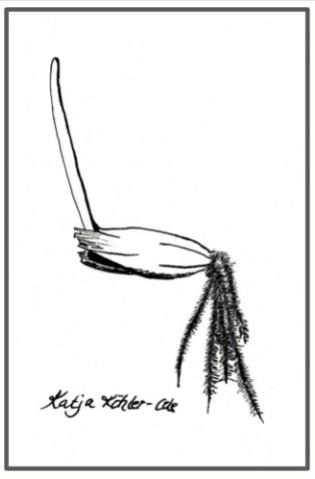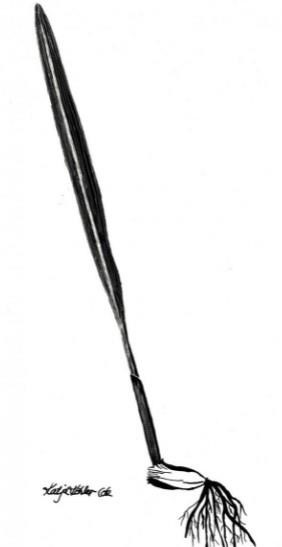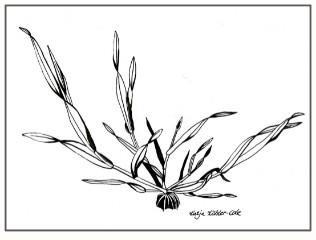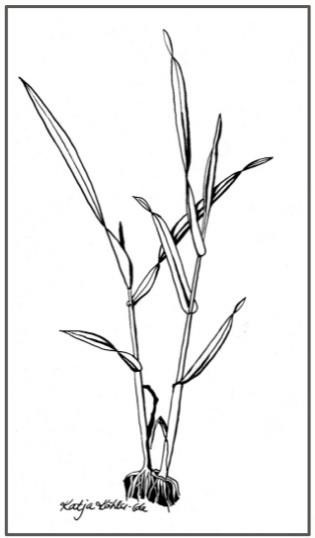By Katja Koehler-Cole
Knowledge about plant growth stages is important for management decisions and to predict how well a plant may cope with stress, such as low temperature. The following figures are illustrations of growth stages that fall-planted cereal cover crops will go through before their termination.
Soil temperature, rainfall and growing degree days determine how quickly plants reach certain growth stages. We give the approximate time of when these growth stages occur in Nebraska depending on cover crop planting and the developmental stages they correspond to on the Zadoks (pronounced ZAH-duks) and Feekes (FEEks) scales.
The Feekes scale is the more common scale in the U.S. It has 11 stages, beginning with emergence (1) and ending with ripening (11). The Zadoks scale divides growth into 10 stages, each stage with 10 sub-stages. The Zadoks scale starts with dry seed (00) and ends with ripening (90).
Germination
Figure 1 is of a germinating oat seed, where the radicle and coleoptile have emerged from the grain. This seed was grown in a pot on top of moist potting soil.
Small grain seed germinates in a few days to several weeks, depending on soil temperature and moisture. Where cover crops are drilled, the germination stage is hidden from view, but it can be seen in broadcast planted cover crops. Sufficient rainfall is critical for the seedlings to survive to and beyond that stage, especially when seeds were broadcast.
The drawing is made at three times the size of the seed (the coleoptile measured about 0.5 inches).
This growth stage corresponds to Zadoks 7.

Figure 1. Germinating oat seed.
Seedling growth
Figure 2 is of an oat seedling during the leaf development or seedling growth stage where the first leaf has unfolded from the coleoptile. Late-planted cover crops — for example, those drilled after corn harvest in November — may only reach this stage before the onset of hard freezes. Winter cereals are vulnerable to winter freeze at this stage.
This plant measured about three inches. It has visible leaf veins and roots that are longer and more branched than what is shown here.
This growth stage corresponds to Zadoks 11 and Fekes 1.

Figure 2. Oat seedling with one true leaf.
Tillering
Figure 3 shows cereal rye at the tillering stage (Zadoks 27, Feekes 3). Rye was broadcast seeded in mid-September into a corn field at Mead, Nebraska.
This drawing was made in early spring, just before the plant resumed growth. It has many tillers and the prostrate growth typical for many small grains during this stage. When small grains reach this growth stage before the onset of winter (as this plant did), they can survive the winter better. They may also produce more biomass than late-planted cover crops due to the large number of tillers formed in the fall.
In our experience, cover crops planted later than October often do not start to produce tillers until the spring and then produce few tillers and little biomass before the stems begin to elongate and boot. Growers may want to use a higher seeding rate when planting late to ensure sufficient cover crop biomass in the spring.

Figure 3. Tillering rye plant.
Stem Extension
Figure 4 is a cereal rye plant at the stem extension or jointing stage (Zadoks 31, Feekes 6). Rye seed was broadcast in mid-September into soybean stands at Mead, Nebraska and reached this stage in late April. The plant was about 12 inches tall and had 20 tillers in varying sizes.
For simplicity, only the main stem and one tiller are shown. Most of the root system was hidden under the soil surface.
Cover crops should be terminated by the end of the stem extension stage, but before the heading stage, to avoid seed production.

Figure 4. Rye at the stem elongation stage.
Materials
The illustrations were made with pen and ink (Winsor technical pen with 102 nib) and scratching knife on Ambersand clayboard.
Acknowledgements
Thank you to Lana Johnson for her guidance on these illustrations.
Source : unl.edu